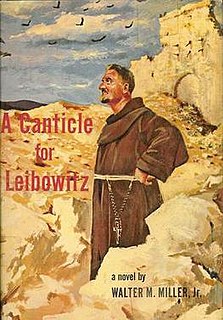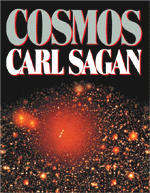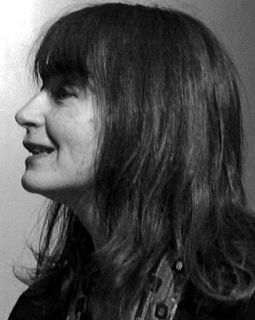
Carl Edward Sagan was an American astronomer, planetary scientist, cosmologist, astrophysicist, astrobiologist, author, poet, and science communicator. His best known scientific contribution is research on extraterrestrial life, including experimental demonstration of the production of amino acids from basic chemicals by radiation. Sagan assembled the first physical messages sent into space: the Pioneer plaque and the Voyager Golden Record, universal messages that could potentially be understood by any extraterrestrial intelligence that might find them. Sagan argued the now-accepted hypothesis that the high surface temperatures of Venus can be attributed to and calculated using the greenhouse effect.

Eric Frank Russell was a British author best known for his science fiction novels and short stories. Much of his work was first published in the United States, in John W. Campbell's Astounding Science Fiction and other pulp magazines. Russell also wrote horror fiction for Weird Tales and non-fiction articles on Fortean topics. Up to 1955 several of his stories were published under pseudonyms, at least Duncan H. Munro and Niall(e) Wilde.

Contact is a 1985 hard science fiction novel by American scientist Carl Sagan. It deals with the theme of contact between humanity and a more technologically advanced, extraterrestrial life form. It ranked No. 7 on the 1985 U.S. bestseller list. The novel originated as a screenplay by Sagan and Ann Druyan in 1979; when development of the film stalled, Sagan decided to convert the stalled film into a novel. The film concept was subsequently revived and eventually released in 1997 as the film Contact starring Jodie Foster.

A Canticle for Leibowitz is a post-apocalyptic science fiction novel by American writer Walter M. Miller Jr., first published in 1959. Set in a Catholic monastery in the desert of the southwestern United States after a devastating nuclear war, the book spans thousands of years as civilization rebuilds itself. The monks of the Albertian Order of Leibowitz preserve the surviving remnants of man's scientific knowledge until the world is again ready for it.

"Ancient astronauts" refers to the pseudoscientific idea that intelligent extraterrestrial beings visited Earth and made contact with humans in antiquity and prehistoric times. Proponents suggest that this contact influenced the development of modern cultures, technologies, religions, and human biology. A common position is that deities from most, if not all, religions are extraterrestrial in origin, and that advanced technologies brought to Earth by ancient astronauts were interpreted as evidence of divine status by early humans.

The Demon-Haunted World: Science as a Candle in the Dark is a 1995 book by the astrophysicist Carl Sagan, in which the author aims to explain the scientific method to laypeople and to encourage people to learn critical and skeptical thinking. He explains methods to help distinguish between ideas that are considered valid science and those that can be considered pseudoscience. Sagan states that when new ideas are offered for consideration, they should be tested by means of skeptical thinking and should stand up to rigorous questioning.

Françoise Sagan was a French playwright, novelist, and screenwriter. Sagan was known for works with strong romantic themes involving wealthy and disillusioned bourgeois characters. Her best-known novel was her first – Bonjour Tristesse (1954) – which was written when she was a teenager.
A book series is a sequence of books having certain characteristics in common that are formally identified together as a group. Book series can be organized in different ways, such as written by the same author, or marketed as a group by their publisher.

Nick Sagan is an American novelist and screenwriter. He is the author of the science fiction novels Idlewild, Edenborn, and Everfree, and has also written scripts for episodes of Star Trek: The Next Generation and Star Trek: Voyager. He is the son of astronomer Carl Sagan and artist and writer Linda Salzman.
Cosmos generally refers to an orderly or harmonious system.

Idlewild is a science fiction novel by Nick Sagan, published in 2003. It is the first of a trilogy, with sequels Edenborn and Everfree. The story is split between two settings: the middle of the 21st century and a generation later. It is a picture of the last ten people on earth, a near-complete pantheon of gods and goddesses.

John Michael Scalzi II is an American science fiction author and former president of the Science Fiction and Fantasy Writers of America. He is best known for his Old Man's War series, three novels of which have been nominated for the Hugo Award, and for his blog Whatever, where he has written on a number of topics since 1998. He won the Hugo Award for Best Fan Writer in 2008 based predominantly on that blog, which he has also used for several charity drives. His novel Redshirts won the 2013 Hugo Award for Best Novel. He has written non-fiction books and columns on diverse topics such as finance, video games, films, astronomy, writing and politics, and served as a creative consultant for the TV series Stargate Universe.
Dorion Sagan is an American author, essayist, fiction writer, and theorist from Madison, Wisconsin. He has written and co-authored books on culture, evolution, and the history and philosophy of science, including Cosmic Apprentice,Cracking the Aging Code, and Lynn Margulis: The Life and Legacy of a Scientific Rebel. His book Into the Cool, co-authored with Eric D. Schneider, is about the relationship between non-equilibrium thermodynamics and life.
"In the Flesh" is the fourth episode of season five of the science fiction television series Star Trek: Voyager, the 98th episode overall. It originally aired on November 4, 1998. The story was written by Nick Sagan, son of astronomer Carl Sagan.

Somnium is a novel written in 1608, in Latin, by Johannes Kepler. The narrative would not be published until 1634 by Kepler's son, Ludwig Kepler. In the narrative, an Icelandic boy and his witch mother learn of an island named Levania from a daemon. Somnium presents a detailed imaginative description of how the Earth might look when viewed from the Moon, and is considered the first serious scientific treatise on lunar astronomy. Carl Sagan and Isaac Asimov have referred to it as one of the first works of science fiction.

Cosmos is a 1980 popular science book by astronomer and Pulitzer Prize-winning author Carl Sagan. Its 13 illustrated chapters, corresponding to the 13 episodes of the Cosmos TV series, which the book was co-developed with and intended to complement, explore the mutual development of science and civilization. One of Sagan's main purposes for the book and television series was to explain complex scientific ideas to anyone interested in learning. Sagan also believed the television was one of the greatest teaching tools ever invented, so he wished to capitalize on his chance to educate the world. Spurred in part by the popularity of the TV series, Cosmos spent 50 weeks on the Publishers Weekly best-sellers list and 70 weeks on the New York Times Best Seller list to become the best-selling science book ever published at the time. In 1981, it received the Hugo Award for Best Non-Fiction Book. The book's unprecedented success ushered in a dramatic increase in visibility for science-themed literature. The success of the book also jumpstarted Sagan's literary career. The sequel to Cosmos is Pale Blue Dot: A Vision of the Human Future in Space (1994).

Old Man's War is a military science fiction novel by American writer John Scalzi, published in 2005. His debut novel, it was nominated for the Hugo Award for Best Novel in 2006.
The 39th World Science Fiction Convention (Worldcon), also known as Denvention II, was held September 3–7, 1981, at the Denver Hilton Hotel in Denver, Colorado, United States.

Inger Edelfeldt is a Swedish author, illustrator and translator.

My Little Pony: Equestria Girls – Legend of Everfree, or simply known as Legend of Everfree, is a 2016 Canadian–American flash animated musical fantasy film sequel to 2015's My Little Pony: Equestria Girls – Friendship Games, written by Kristine Songco and Joanna Lewis, and directed by Ishi Rudell. The film was produced by DHX Media's 2D animation studio in Vancouver, Canada for Hasbro Studios in the United States as a part of Hasbro's Equestria Girls toy line and media franchise, which is a spin-off of the 2010 relaunch of My Little Pony. Prior to its release in the United States on Netflix on October 1, 2016, the film was first broadcast on Discovery Kids in Latin America on September 24, 2016. It received a home media release in the United States and Canada on November 1, 2016. The film received mixed reviews from critics, who praised the animation, voice acting and music, but criticized its script, plot and excessive use of too many plotlines all at once.















